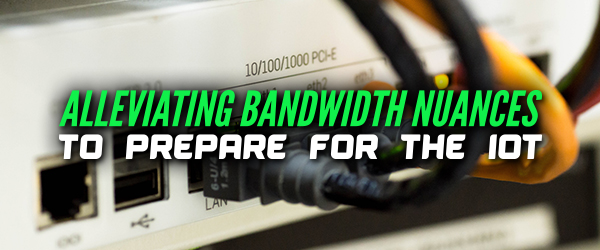
Alleviating Bandwidth Nuances to Prepare for the IoT
The Internet-of-Things (IoT) is here, and its impact is already being felt in a wide range of industries. What is IoT? At the most basic level, it refers to connecting a myriad of devices to the Internet to provide real-time data, feedback, and control, which allows companies and individuals to respond more quickly and to make data-informed decisions.
One of the biggest drivers of IoT has been increased bandwidth. Ultimately, extensible connectivity is a necessary foundation for building a truly diverse, robust, and dynamic Internet-of-Things. With such a network, companies will be able to control remote physical assets in real-time. Yet as bandwidth enables the Internet-of-Things, IoT will also burden Internet networks with ever-increasing flows of data.
Let’s examine some of the more complex implications of IoT and also why bandwidth is so important. In the future, bandwidth and IoT could create smart cities enabled by Smart Vaults, lights, sensors and everything else.
More IoT Devices Are Being Connected Every Day
IoT is only going to grow in importance in the years ahead as processors continue to shrink, battery life increases, and Internet connections become faster, more widespread, and more stable. Right now, we have IoT oases; IoT devices crowd around the pockets where Internet connections are strong. However, as bandwidth proliferates, the Internet-of-Things will grow.
By 2020, some 25 billion IoT devices will be connected. This mass connectivity will create a reliance on Ipv6 addressing, which means every single device will have a unique public IP address. However, this increased demand for bandwidth will strain current-day bandwidth systems.
The Risks Associated With Growth
Allocating enough bandwidth has emerged as a challenge. It’s not just that more devices will be connected. Devices are going to be connected in increasingly novel ways, and even small, simple IoT devices could generate a lot of data and thus demand greater bandwidth. Add in a complex IoT, such as a full smart city, the need for bandwidth will only increase.
Indeed, the IoT is only possible because of data transfers, and if networks are overloaded, the web of devices itself will collapse. There’s no cure-all for the bandwidth challenges that the IoT will generate. Every challenge is going to require its own unique, targeted solution.
Network Investments Can Alleviate Shortages
Investing in networks can help alleviate various issues. However, these investments must be targeted and well-thought. Consider latency. A network cannot allow for high latency when data and actions are time sensitive. A self-driving car, for example, must be updated with information in real time.
Quick response times necessitate bandwidth for time-sensitive activities. In other words, networks must have low latency. At the same time, not every bit of data must be transferred immediately, and indeed, it may not be possible to build networks that would enable such. Thus, bandwidth solutions will have to prioritize data.
Compromise and Create Solutions
Ultimately, the ever-expanding amount and nature of data that is crossing the World Wide Web is going to make data delivery more vital, but also potentially less certain. We’re going to have to rethink how data is delivered and may have to make some difficult choices. Ultimately, we must accept that we cannot get all the data we want, or formulate a new approach.
Ideally, we would be able to collect all of the data we want without filtering or compromising in another fashion all in real time. However, in reality, compromises will most likely have to be made. Fortunately, compromising doesn’t have to “compromise” your overall efforts.
Consider a large-scale industrial operation, say for example fleet management. Parts of the fleet, such as routes, may have to be monitored in real time. Other parts of the fleet, such as non-critical maintenance data, could be stored until when bandwidth is freed up. Thus, real-time data is sent in real time, while less vital data is sent when bandwidth is available.
Enhanced Data Flow and the Internet-of-Things
Traditional approaches, such as WAN optimization, may no longer be enough to deal with data-related challenges. The massive amounts of data generated by IoT must be protected, backed up, and moved, causing more headaches. Add the need to encrypt or compress data, and the old way of doing things becomes even more of a liability.
Static options to increase performance simply may not be enough. Such solutions may provide some benefits, and they may even prove effective for a time. However, as the IoT grows, static solutions run the risk of being less effective. This may force more compromises.
AI Will Be An Ally
Network managers and others won’t have to handle everything on their own. Advanced AI solutions can be used to identify trends and to filter out irrelevant data. AI can also identify seemingly minor trends that have the potential to emerge as significant problems as time progresses, allowing network administrators and other relevant parties to act proactively.
AI systems will help make sense of huge data flows by allowing accurate but quick analysis. AI can also grasp and grapple with vast quantities of data that may be too big for the average human analyst to control single-handedly. Indeed, AI may be necessary for an IoT driven world. Consider all of the data generated by a smart city, can any analyst grasp all of it on their own? Probably not, but with AI the challenge will become more approachable.
Wrapping Up With Tips and Considerations
It’s important to consider the network architecture that will be used to receive and transmit data. Simple solutions, such as cellular 5G networks, may not be enough. On the other hand, having more bandwidth than necessary could also create obstacles such as infrastructure challenges cities will encounter when implementing smart city technology.
The question is: Where will all the equipment needed to establish this network go?
In densified areas, poles and roadside cabinets are becoming cluttered with small cells. The added clutter is not only an ugly addition to a city but are likely to become outdated and will need to be serviced.
With the SYNDÉO Smart Vault, you can place small cell equipment under ADA curb ramps, sidewalks and terraces to reduce the clutter of the tech needed for a smart city network. This gives easy access to the devices so they can be updated or swapped out for the newest tech. Additionally, the Smart Vault’s are designed with the outdoor environment in mind, with a thermally controlled environment and a waterproof guarantee to ensure the devices are safe from the elements.
It is obvious that there is a huge demand for this technology, but cities will need to be strategic on how and where they deploy the necessary equipment to become the city of the future.

